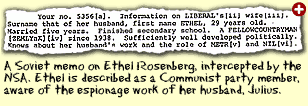Red Scare revisited
Was McCarthy right about Soviet espionage?
By Dr. Harvey Klehr
Emory University
Sen. Joseph McCarthy's name continues to reverberate in American life, almost half a century after a speech in which he proclaimed that he held in his hand a list with the names of scores of American government employees who had betrayed their country to the Soviet Union.
McCarthyism has entered the political lexicon to refer to a political style or method that crosses the bounds of decency. To accuse someone of McCarthyism is to charge him with an unwarranted political smear. Virtually all historians today judge McCarthy to have been a demagogue who made false and misleading charges.
Thanks primarily to McCarthy, most Americans identify the anti-Communist investigations and hearings of the late 1940s and early 1950s as a shameful episode in American life during which a non-existent communist threat was used to pillory innocent people for their political beliefs. The McCarthy era is routinely portrayed in textbooks as an age of hysteria.
With the end of the Cold War and the collapse of the Soviet Union, a number of new archival sources have become available that throw much-needed light on the McCarthy era and the attack on domestic communism. More and more FBI files on the Communist Party U.S.A. have been released; Russian archives holding the records of the Communist International and the CPUSA have allowed access to American scholars; and the Venona cables, decrypted World War II Soviet messages between KGB offices in the United States and Moscow, have been released by the National Security Agency.

This new evidence is forcing the revision of many of the prevailing myths about the internal communist threat to American democracy in the postwar era. None of it exculpates McCarthy. He remains a political bully who hurt a number of people. But his exaggerated and baseless charges also harmed the anti-communist cause. In a variant of Gresham's Law, his bad charges trivialized and weakened good ones. Genuine Soviet spies portrayed themselves as victimized by McCarthyism. They found sympathetic listeners, convinced that anyone accused of espionage or communism must be innocent because some innocent people were accused.
The new evidence demonstrates that Julius Rosenberg was an important Soviet agent in charge of a spy ring that obtained scientific secrets, including material relating to the atomic bomb.
It confirms that Alger Hiss was an important Soviet agent from the mid-1930s through the 1940s, turning over State Department secrets to Soviet military intelligence.
Elizabeth Bentley, a Soviet spy who defected in 1945, identified dozens of government officials she claimed had turned over information to her during World War II. Bentley was widely disbelieved and derided as the "blond spy queen." None of those she named was ever successfully prosecuted for espionage (one was convicted on a related charge). The new evidence demonstrates conclusively that she told the truth. Among her sources were a top-ranking officer in the Office of Strategic Services, officials in the War Production Board, Board of Economic Warfare, State Department, War Department, Army Air Force, Office of War Information, Treasury Department, and the Office of Coordinator of Inter-American Affairs.
In fact, more than 350 Americans secretly worked for Soviet intelligence during World War II -- when the United States and the Soviet Union were allies. A number of them served in very high positions in the U.S. government. Harry Dexter White was assistant secretary of the Treasury and played a key role in creating the World Bank and the International Monetary Fund, pillars of the postwar world monetary structure. Lauchlin Currie was one of a half-dozen special assistants to President Franklin Roosevelt. Laurence Duggan was in charge of U.S. relations with Latin America.
All of these spies were uncovered in the Venona decryptions in the late 1940s. But the spies uncovered by Venona were only part of the security problem faced by U.S. counter-intelligence agencies. Fewer than half of the Americans mentioned in the Venona cables were able to be identified; the others were hidden behind cover names that the FBI could not penetrate. Who were the other 150 Americans who worked for the KGB? Had they remained in the government or the military? Were they scientists still working in Los Alamos?
And what about the targeting of American communists as security risks? We now know that the CPUSA had set up a special "underground apparatus" that helped Soviet intelligence recruit party members as spies, helped locate safe houses for meetings, secured false passports for agents, and otherwise assisted the Soviet Union. Headed by a veteran communist leader, this apparatus reported directly to the leader of the Communist Party. Most American communists were not spies, of course, but the party to which they belonged was neck-deep in espionage.
McCarthy's wild charges did not help uncover Soviet spies. But there were spies, there was a legitimate security issue and there were very good reasons for suspecting that most of the spies were American communists. None of that excuses the excesses of McCarthyism, but it also puts the era of McCarthyism into context. The Soviet Union had mounted a major espionage offensive against the United States, using hundreds of American citizens as its weapons. And the Communist Party U.S.A. was organizationally complicit in espionage.
Klehr is a professor of politics at Emory University in Atlanta and author of a forthcoming book on Soviet espionage in the United States.